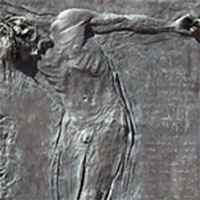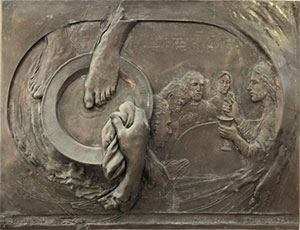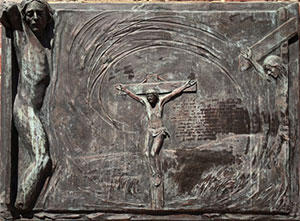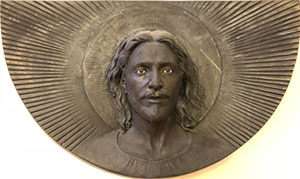 Bronze sculptures (c. 2000)
Bronze sculptures (c. 2000)
University of Notre Dame, Freemantle, Western Australia
The 14 Stations of the Cross by Australian sculptor Peter Schipperheyn were commissioned around the year 2000 for the University of Notre Dame, Freemantle, Western Australia.
Born in 1955 of Dutch heritage, Peter Schipperheyn studied in Melbourne completing a Diploma in Fine Art at the Caulfield Institute of Technology in 1978 and also in Italy where he undertook studies at the Academia di Belle Arti.
His sculptures enjoy wide acclaim, especially his figurative works in carrara marble. Schipperheyn’s works have been featured in art galleries and private collections throughout Australia and internationally. Some of his more famous works include sculptures of Dame Joan Sutherland in the Sydney Town Hall (1988), Sir Eric Westbrook in the National Gallery of Victoria (1991) and the Eternal Flame in the Holocaust Museum, Melbourne (1998).
Amongst his overtly religious works is the evocative baptismal font for St Stephen’s Cathedral in Brisbane and the set of 14 scripturally inspired Stations of the Cross for the University of Notre Dame.
It is beyond the scope of this commentary to focus on each station, however, a few of the stations are especially noteworthy for the way they express key theological themes associated with Christ’s passion and death in scripture and the Easter liturgies.
 The first station, the Last Supper, connects Jesus’ institution of the Eucharist at the last supper with his gift of self in service of others through washing his disciples’ feet, a connection that comes to us from John’s Gospel. Hands and feet figure prominently in this work. Jesus’ gift of his body and blood at the Last supper pre-figured the gift of his life for the salvation of the world the following day on Calvary. Those served by Jesus are called to follow his footsteps and serve others.
The first station, the Last Supper, connects Jesus’ institution of the Eucharist at the last supper with his gift of self in service of others through washing his disciples’ feet, a connection that comes to us from John’s Gospel. Hands and feet figure prominently in this work. Jesus’ gift of his body and blood at the Last supper pre-figured the gift of his life for the salvation of the world the following day on Calvary. Those served by Jesus are called to follow his footsteps and serve others.
 The ninth station, Jesus is Nailed to the Cross, depicts the dreadful agony of Jesus prior to his death. His mouth and right ear appear “open” in this partly three-dimensional texture, perhaps suggesting Jesus’ openness to God’s will and his thirst for the breath of life and water as they ebb away from his suffering body. The resignation of Jesus to his passion and death is captured by his left hand which reaches beyond the frame of the station, perhaps beyond the limitations imposed by human expectations.
The ninth station, Jesus is Nailed to the Cross, depicts the dreadful agony of Jesus prior to his death. His mouth and right ear appear “open” in this partly three-dimensional texture, perhaps suggesting Jesus’ openness to God’s will and his thirst for the breath of life and water as they ebb away from his suffering body. The resignation of Jesus to his passion and death is captured by his left hand which reaches beyond the frame of the station, perhaps beyond the limitations imposed by human expectations.
 The tenth station, Jesus and the Good Thief, depicts the repentant prisoner with his head inclined towards Jesus who hangs on the cross in a posture of repose and serenity. The plea of the repentant thief recounted in scripture “Remember me when you come into your kingdom” seems to resonate with Jesus. By contrast, the unrepentant thief is depicted looking away from Jesus, seemingly disinterested in the forgiveness that Jesus offers.
The tenth station, Jesus and the Good Thief, depicts the repentant prisoner with his head inclined towards Jesus who hangs on the cross in a posture of repose and serenity. The plea of the repentant thief recounted in scripture “Remember me when you come into your kingdom” seems to resonate with Jesus. By contrast, the unrepentant thief is depicted looking away from Jesus, seemingly disinterested in the forgiveness that Jesus offers.
 The fourteenth and last station depicts the Resurrection of Jesus. This sculpture is presented in sharp contrast to all the others. What strikes the viewer is the vibrant face of the resurrected Christ, fully alive with rays of light emanating from his face. Although this station is not always included in the so called “traditional” series of stations, it’s inclusion here serves to connect Christ’s passion with his resurrection, a more complete representation of Christ’s paschal mystery.
The fourteenth and last station depicts the Resurrection of Jesus. This sculpture is presented in sharp contrast to all the others. What strikes the viewer is the vibrant face of the resurrected Christ, fully alive with rays of light emanating from his face. Although this station is not always included in the so called “traditional” series of stations, it’s inclusion here serves to connect Christ’s passion with his resurrection, a more complete representation of Christ’s paschal mystery.
Edmund Capon, formerly Director of the New South Wales Art Gallery, suggests that Peter Schipperheyn’s art and vision is wholly inspired by the great figurative traditions in Western art . . . no other living Australian artist has so totally dedicated himself to seeking a truly contemporary expression of Western arts most inspired tradition. Peter Schipperheyn’s work expresses hope, sensitivity, classicism, contemporaneity: it shows above all that the fundamental concerns and emotions of mankind, like great art, transcend time.
Dr Paul Taylor
Executive Secretary – Bishops Commission for Liturgy
Australian Catholic Bishops Conference
